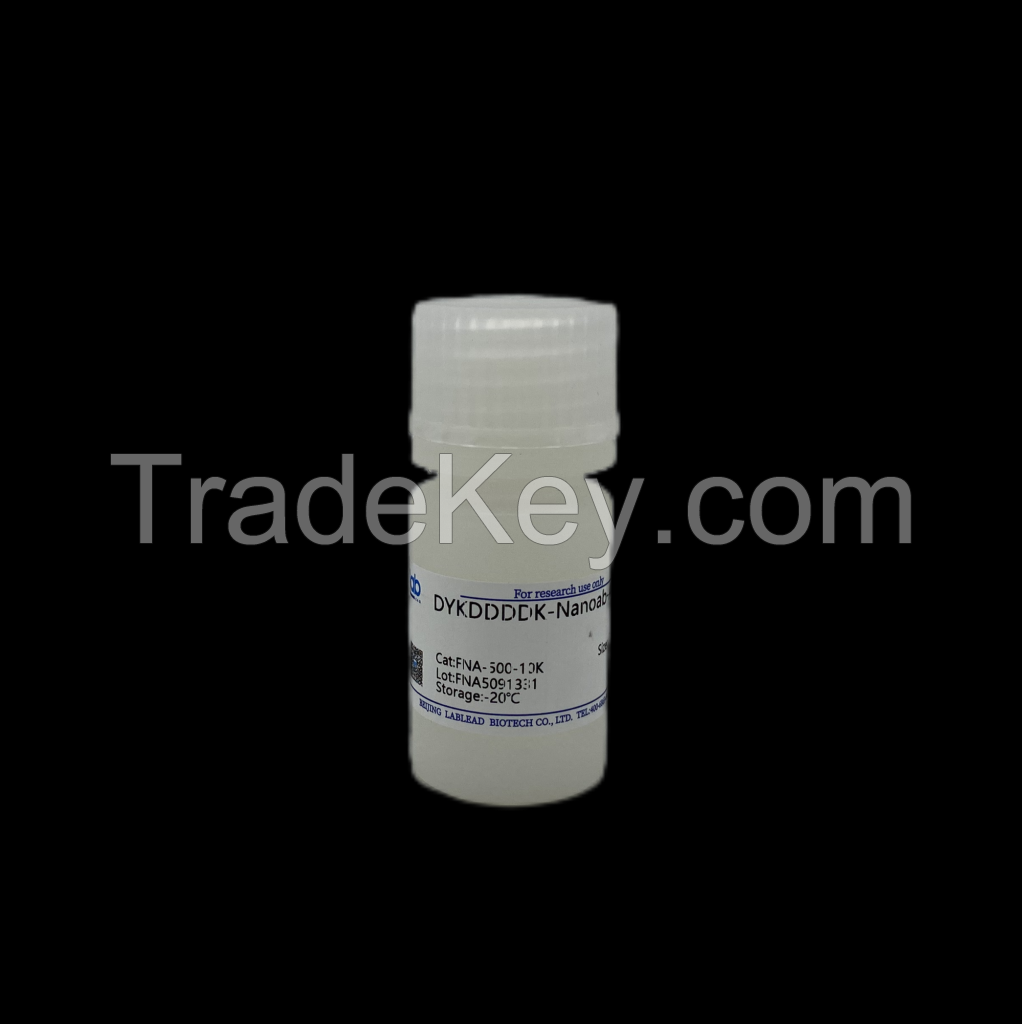详情
DYKDDDDK-Nanoab-Agarose
beads CAT:FA***0
Price:
Storage conditions: 2℃*8℃ for short-term
storage; **0℃ for long-term storage
1. Product
introduction The Flag tag is a polypeptide fragment
composed of eight hydrophilic amino acids, located on the surface
of the fusion protein, so it is easier to bind to antibodies and
be decomposed by enterokinase. DYKDDDDK-Nanoab-agarose Beads uses
anti-Flag (DYKDDDDK) nanoantibodies as affinity ligands to purify
Flag tag fusion proteins expressed in prokaryotes, yeast or
mammalian cells in one step.
DYKDDDDK-Nanoab-agarose Beads uses 4% agarose
gel as a matrix, with less non-specific binding of impurities,
and can be used for purification and immunoprecipitation (IP) of
Flag tag fusion proteins.
2. Reagent
preparation 2.1 Sample
preparation Before loading the column, ensure that the
sample solution has a suitable ionic strength and pH value. The
sample or cell culture medium can be diluted with an equilibrium
solution, or dialyzed with an equilibrium solution. It is
recommended to centrifuge or filter the sample with a 0.*2 um or
0.*5 um filter membrane before loading to reduce impurities,
improve protein purification efficiency and prevent column
clogging. 2.2 Preparation of
buffer It is recommended to filter the water and
buffer with a 0.*2 um or 0.*5 um filter membrane before
use. Balance/washing solution: *0 mM Tris, 0.*5 M
NaCl, pH7.4 Acidic eluent: 0.1 M glycine HCl,
pH3.0 Competitive eluent: *0 mM Tris, 0.*5 M NaCl,
******0 ug flag peptide/ml, pH7.4
Neutralizing solution: 1 M Tris-HCl,
pH8.0 3. Sample
purification 3.1 Column
chromatography 1) Load DYKDDDDK-Nanoab-agarose Beads into a
suitable chromatography column, and balance the chromatography
with 5 column volumes of balance solution to keep the filler in
the same buffer system as the target
protein. 2) Add the sample to the balanced
DYKDDDDK-Nanoab-agarose Beads, collect the effluent, and repeat
the sample loading to increase the binding
efficiency. 3) Wash with *0 column volumes of washing
solution to remove non-specific adsorbed impurities and collect
washing solution. 4) A acid elution: Use 5 column volumes of
acid elution solution for elution, add neutralizing solution in
the collection tube in advance, add ****5 ul neutralizing
solution/ml elution solution, and collect in separate
tubes. Note: After acid elution, the filler should
be immediately equilibrated with equilibration solution, and
DYKDDDDK-Nanoab-agarose Beads should not be in the elution
solution for more than *0 min.
B competitive elution: Use 5 column volumes
of competitive elution solution for elution. Collect in separate
tubes. 5) Regenerate with 3 column volumes of
elution solution, and then equilibrate to neutrality with
equilibration solution.
6) Then store in PBS solution containing *0%
ethanol at **8℃.
3.2 Static
adsorption 1) Preparation of filler: Take an appropriate
amount of DYKDDDDK-Nanoab-agarose Beads and add them to the
chromatography column, drain the protective solution. Add 5 times
the column volume of equilibrium solution for
washing. 2) Add sample solution and incubate at 4℃ or
room temperature for at least *0 min (magnetic stirring is not
allowed) to ensure that the filler and sample solution are fully
mixed. 3) After incubation, centrifuge the filler
mixture (***0×g for 1 min) or filter to collect the
filler. 4) Load the filler into the chromatography
column and wash with equilibrium solution until it is UV
stable. 5) Elute with acidic eluent or competitive
eluent, refer to 4 in 3.1).
6) Refer to 5) and 6) in 3.1 for filler
regeneration and storage.
3.3 Immunoprecipitation operation
process 1) Filler preparation: Take *0ul of
DYKDDDDK-Nanoab-agarose Beads (column volume *0 pl) mixed
solution and add it to a 2ml centrifuge tube, centrifuge at
***0xg for 1 min, and discard the
supernatant. 2) Add 0.5ml of equilibration solution to the
filler, suspend the filler (make the filler in the same buffer
system as the target protein to protect the protein), centrifuge
at ***0×g for 1 min, and discard the supernatant. Repeat
once. 3) Add ******0uI sample lysate to the treated
filler, mix evenly, place it in a flip mixer at room temperature
and gently flip the centrifuge tube to promote full contact and
adsorption between the sample and the filler, at room temperature
for at least 1 hour. Centrifuge at ***0xg for 1 min, and discard
the supernatant. 4) Washing: Add 0.5ml of washing solution,
suspend the filler, mix gently, centrifuge at ***0xg for 1 min,
and discard the supernatant. Repeat three more times. Ensure that
non-specific adsorption is removed.
5) Sample elution: Different elution methods
can be selected according to the needs of subsequent
detection. A: Acid elution
Add **0ul acid elution solution to suspend
the filler. Incubate at room temperature for 5 min, centrifuge at
***0xg for 1 min. Carefully remove the supernatant, do not absorb
the filler, and neutralize with neutralizing solution. Place the
eluted sample at 4℃, and store it at **0℃ for a long
time. B: Competitive
elution Add **0ul competitive elution solution to
elute. Incubate at room temperature for *0 min, centrifuge at
***0×g for 1 min. Carefully remove the supernatant, do not absorb
the filler. Place the eluted sample at 4℃, and store it at **0℃
for a long time. C: Denaturation
elution The sample buffer containing SDS can denature
the DYKDDDDK antibody, and the eluted DYKDDDDK-Nanoab-agarose
Beads cannot be reused.
Add *0 ul of 2× Loading Buffer to each tube
and heat at *5℃ for 5 min. Centrifuge at ***0xg for 1 min and
aspirate the supernatant for SDS-PAGE
electrophoresis.
| 国家: |
China |
| 型号: |
-
|
| 离岸价格: |
(面議)
获取最新报价
|
| 位置: |
China |
| 最小订单价格: |
- |
| 最小订单: |
- |
| 包装细节: |
- |
| 交货时间: |
- |
| 供应能力: |
- |
| 付款方式: |
T/T, L/C, D/A, D/P, Western Union, Money Gram, PayPal, Other |
| 產品組 : |
Protein Biology
|


